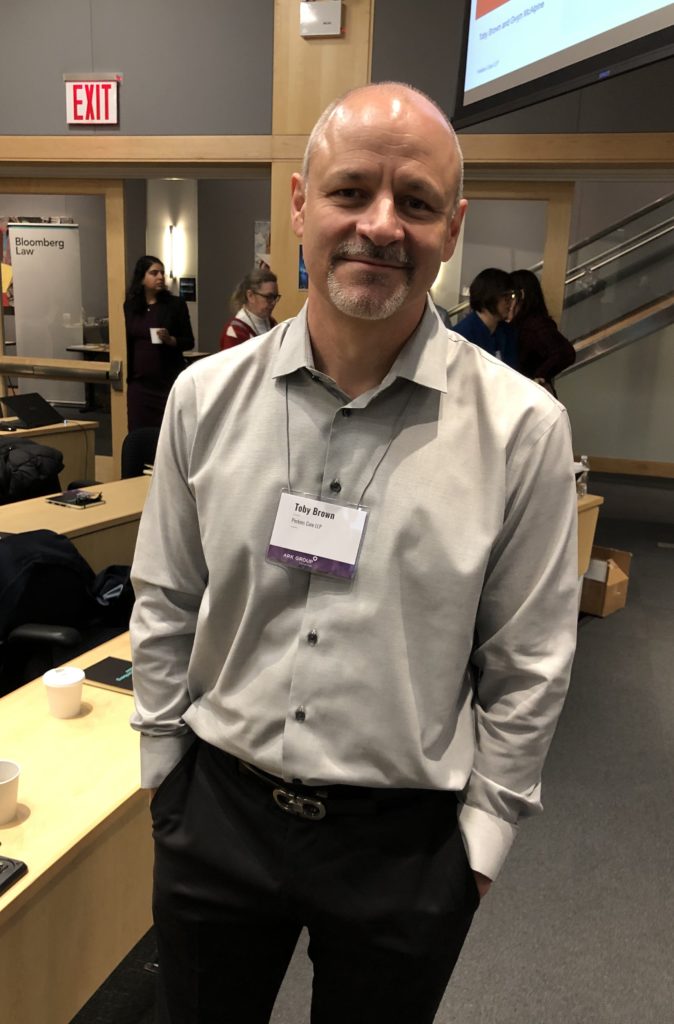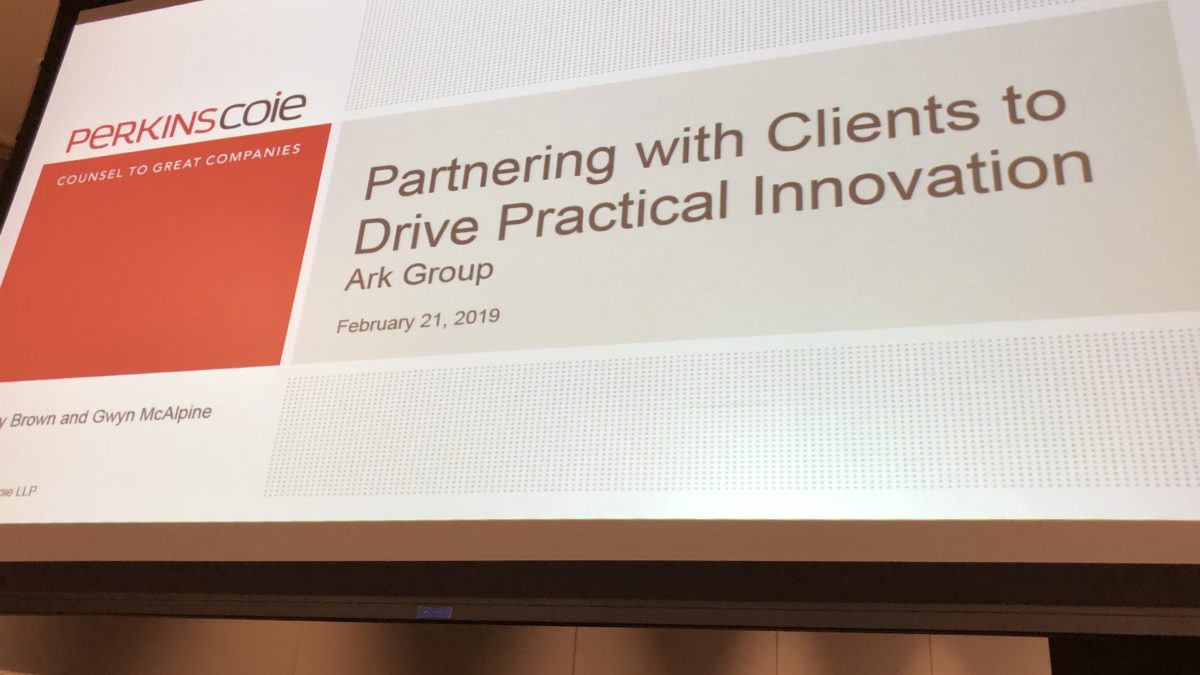This is a live post of the session Partnering with Clients to Drive Practical Innovation at the Ark conference Best Practices & Management Strategies for Law Firm Library, Research & Information Services (aka Ark Library). The presenters are Toby Brown, Chief Practice Management Officer, Perkins Coie LLP and Gwyneth McAlpine, Director of Knowledge Management Services, Perkins Coie LLP. The full session description appears at the end.


This is a live post. I publish it as a session finishes. Please excuse any typos or misunderstandings of meanings.
Toby relates a challenge from years ago, from Kingsley Martin: how many steps are you from revenue? At the time, Toby says he was many steps away from revenue. If you are just billing time, you are two steps – write it down, then collect. But selling is direct.
Toby now use the “profit needle” as the key metric. Yesterday someone who reports to him proposed an initiative re proposals. His questions was “how much will this move the profit needle?” Just asking caused her to say “never mind”.
The goal is always to get closer to revenue. Toby went to law firm innovation conference in the fall. He blogged about it, calling “law firm innovation” then next BS phrase. The point is, innovation is many steps away from actual new revenue. Most innovation is not adopted firm-wide; if lucky, one practice or a few lawyers adopt it.
Today, Toby and Gwyn will talk about moving the profit needle by working more closely with clients. The problem is that client say they want innovation. But what they really want is efficiency. And they don’t really want to change what they do. And even if you do a fixed fee, lawyers may not change.
To get real change and efficiency, you have to bake it into the engagement, working with the client. And this is hard because partners read about innovation and that generates internal questions “are we doing that.” Even when innovation or KM folks “do innovation”, it does not answer the question, “who will sell it?” It’s hard enough to get lawyers to sell traditional legal services – why expect them to sell “innovation”.
Perkins Coie has a big retail client. It had a contract review challenge. Firm had been doing some of that work but client had a much bigger tranche it needed help with. That work was being done by one expensive lawyer at another firm. Beyond expense, it was not consistent – and it depended on one person. Client did not just want to change lawyers and replicate problem.
Perkins has a program, Client Advantage ™. Premise is that legal operations professionals have jobs that are too big. Take Google. It has 20 legal ops people for 1000 lawyers. At law firms, ratio is closer to 1:1. Client Advantage taps the firms operations expertise to help legal ops professionals at clients.
At this retail client, the partner involved was open minded to a new approach. Toby and his team ran several scenario models. Most included using non-partner track lawyers – which substantially reduced cost. It also involved a change to the intake process. That process was extended into the client.
Extending intake to client is actually a big deal. It reduces a lot of the friction of figuring out what a matter is about. And it includes asking client about importance and value of a matter. The answers drive how much work is done.
For example, Microsoft asked for a 50-country legal survey. As part of intake, Perkins asked the importance and value question. Those answers caused mutual agreement to focus mainly on just 5 countries. (In contrast to over spending to cover all 50 in depth.)
To get to the new approach at retail company, firm had to actively engage the client, at outset and ongoing basis. The legal ops person had to take chance to push for change in her company. The firm helped the legal ops person with the internal corporate selling. One in-house lawyer was very resistant. Firm helped legal ops sell the engagement on a fixed fee basis.
The key point here is that this program is very close to revenue. Toby worked with the lawyer to sell new business. Client reaction was very positive and included several tweaks in approach over time (a few months since it went live). Gwyn reports there were weekly meetings initially.
For this engagement, technology was a minor piece. The big piece was changing the process.
Gwyn explains how to approach clients with innovation. Start by working client to explain the approach, gain buy-in. KM is involved, not directly with the selling, but with Toby to make sure delivery will work and be profitable. In that initial phase, firm does some process mapping with client. That’s part of initial scoping discussion.
Next step is to build proof of concept. Direct client contact by KM becomes very important here because the firm needs to collect a lot of detail from the client. Gwyn notes that lawyers don’t usually like to sit through these meetings. But multiple iterations were required to collect the right information to handle each matter appropriately.
Once the design was done, the firm had to execute on the mechanics of doing the work. For example, associates were not part of client discussion. They need to be informed how to handle the work. Key success factors include:
- Listen carefully
- Tech skill
- Process maps
- Ability to translate process to changes in how lawyers work
- Gain buy-in to process
- Detail orientation
- Strong client service sensibility
The firm has replicated this type of process for several portfolio, fixed fee engagements. All include process mapping, extending intake into client, tracking metrics. Each one is slightly different. But overall success factors discovered after several deal like this include:
- Need the right type of client that is ready
- Right partner at the firm. It’s a long process that requires upfront investment and close collaboration. Not all partners willingly work with operations professionals
- Right strategy: There is significant investment upfront – make sure there is a pay off and that the initiative fits with firm strategy. Is this area of work the firm wants to invest in? The right client? Is it replicable? Don’t just do – make sure it fits.
- Focus on the right place at the client. It may not always be at what client views as Tier 1; often the bigger pain point is higher volume, Tier 2 work.
- Consider negotiating multiyear deal, which assures buy-in and enables bigger upfront investment. It also relieves clients of many hassles of detailed bill review and yearly negotiating.
- The above are the high level factors. At the more detailed level, additional factors include….
- Standardizing (eg, playbooks)
- Detailed process maps with exceptions (breaks) spelled out for manual work. Figure out what’s worth automating.
- Metrics. All these details involve client facing dashboards. But there are also metrics the firm tracks such as how long a task sits somewhere and what cycle times are at a detailed level.
So at a high level, the lessons learned:
- Bring KM in early to address operations at outset. Otherwise, firm may face very big change orders or mis-set expectations
- Standardize workflows across like matters. This is key to achieve scalability. Firm has built as it went but is moving to industrializing.
- Anticipate the change management and adoption planning required. Even if client and partner are onboard with change, you still need to persuade the troops. Firm has a checklist to help with this. Plus a lot of training. Use LPM team for monitor and enforcement of change.
Q&A not captured
Session Description (Screenshot)

Archives
Blog Categories
- Alternative Legal Provider (44)
- Artificial Intelligence (AI) (57)
- Bar Regulation (13)
- Best Practices (39)
- Big Data and Data Science (14)
- Blockchain (10)
- Bloomberg Biz of Law Summit – Live (6)
- Business Intelligence (21)
- Contract Management (21)
- Cool Legal Conferences (13)
- COVID-19 (11)
- Design (5)
- Do Less Law (40)
- eDiscovery and Litigation Support (165)
- Experience Management (12)
- Extranets (11)
- General (194)
- Innovation and Change Management (188)
- Interesting Technology (105)
- Knowledge Management (229)
- Law Department Management (20)
- Law Departments / Client Service (120)
- Law Factory v. Bet the Farm (30)
- Law Firm Service Delivery (128)
- Law Firm Staffing (27)
- Law Libraries (6)
- Legal market survey featured (6)
- Legal Process Improvement (27)
- Legal Project Management (26)
- Legal Secretaries – Their Future (17)
- Legal Tech Start-Ups (18)
- Litigation Finance (5)
- Low Cost Law Firm Centers (22)
- Management and Technology (179)
- Notices re this Blog (10)
- Online Legal Services (64)
- Outsourcing (141)
- Personal Productivity (40)
- Roundup (58)
- Structure of Legal Business (2)
- Supplier News (13)
- Visual Intelligence (14)

